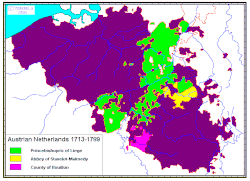List of wars in the southern Low Countries (1560–1829)
This is a list of wars that occurred in the southern Low Countries between 1560 and 1829.

Unlike the 'Northern Netherlands', where a set of united provinces and cities proclaimed its independence in 1581 and would become the Dutch Republic in 1588, the southern Low Countries would remain dependent territories throughout this time. These non-sovereign territories included the Habsburg-owned Southern Netherlands (Spanish Netherlands until 1715, Austrian Netherlands until 1795), the Prince-Bishopric of Liège (until 1795), the Princely Abbey of Stavelot-Malmedy (until 1794), the Prince-Bishopric of Cambrésis and the Imperial City of Cambray (until 1678), the Duchy of Bouillon (until 1795), and some western parts of the Duchy of Jülich (until 1795). Aside from these, there were various other small political entities such as the County of Enghien (until 1569), the Imperial Lordship of Kessenich (until 1784), the Duchy of Aarschot, the Duchy of Hoogstraten, the County of Horne, the Double Lordship of Maastricht, the Redemptiedorpen, the County of the Vroenhof (all until 1795), and so on. During the Brabant and Liège Revolutions (1789–1791), the United Belgian States and Liège Republic briefly achieved de facto independence, but remained unrecognised before the Habsburgs restored their power, and French Revolutionary armies soon conquered all the southern Low Countries and annexed them into the French First Republic in 1795. Most of the Low Countries were unified in 1815 as the newly created United Kingdom of the Netherlands under the House of Orange-Nassau, in personal union with the newly created Grand Duchy of Luxembourg, until the Belgian Revolution broke out in 1830.
- For earlier wars, see List of wars in the Low Countries until 1560.
- For simultaneous wars in the Northern Netherlands, see List of wars involving the Netherlands (1560–present)
- For subsequent wars in the southern Low Countries, see
- List of wars involving Belgium (1830–present), from the Belgian Revolution onwards
- List of wars involving Luxembourg (1890–present).
- War of succession
- War of conquest (territorial control)
- Religious war (European wars of religion)
- Economic war
- Revolt or rebellion (political)
Notes
- Liège was neutral during the Eighty Years' War, but its neutrality was violated by the Dutch occupation of Huy in 1595. The prince-bishop of Liège appealed to the Spanish governor in Brussels for aid in driving the Dutch out, which was granted, after which the city was restored to Liégeois control.
- Lord Wentworth's Regiment was integrated into the Spanish army.
- Portugal declared its independence from Spain in 1640, triggering the Portuguese Restoration War. Although the Portuguese were already engaged in the Dutch–Portuguese War since 1602, they agreed to a 10-year truce with the Dutch Republic in Europe (1640–1650) while both were fighting for independence from Spain; nevertheless, the colonial war between the Portuguese and the Dutch West India Company (WIC) in the Americas (especially Dutch Brazil) continued.
- Stavelot-Malmedy was neutral during most wars, but in 1689 severely attacked by France.
- Holy Roman Emperor Francis II of Habsburg proclaimed the Austrian Empire on 11 August 1804, elevating the Habsburg Monarchy to imperial status by himself. The indirect causes of this move are the French conquest of the Rhineland and further expansion into Germany and the Reichsdeputationshauptschluss of 1803, which curbed the meaning and power of the Holy Roman Empire/Emperor. The direct cause of Francis' proclamation was the adoption of the new French Constitution of 18 May 1804, which appointed Napoleon as Emperor of the French (followed by his coronation on 2 December 1804). Instead of an increasingly meaningless and non-hereditary title that was dependent on the cooperation of the Electors and was limited to only the northwestern parts of his Hausmacht, Francis now made all Austrian Habsburg possessions into a unified hereditary empire.
- Duchy of Warsaw as a state was in effect fully occupied by Russian and Prussian forces by May 1813, although most Poles remained loyal to Napoleon.
- Many member states of the Confederation of the Rhine defected after Battle of Leipzig.
References
- Tony Kellen (1897). Malmedy und die preussische Wallonie (in German). Fredebeul & Koenen. p. 18.
